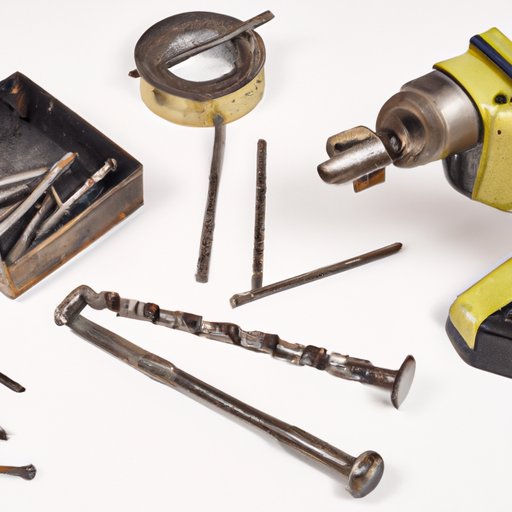
I. Introduction
Dealing with a stripped bolt can be a frustrating and time-consuming ordeal, but it’s important to address it promptly to avoid causing further damage or delaying your project. Fortunately, there are several effective methods for removing stripped bolts, and we’ll cover them all in this article with easy-to-follow instructions and helpful tips.
II. Use Vise-Grips
One of the easiest and most common methods for removing a stripped bolt is to use a pair of vise-grips. Here’s how to do it:
1. Choose the right size vise-grips for the bolt you’re trying to remove. Too small and they won’t grip the bolt; too large and they could damage the surrounding area.
2. Clamp the vise-grips tightly onto the bolt, making sure the jaws are gripping as much surface area as possible.
3. Turn the vise-grips counterclockwise to loosen the bolt. If it doesn’t budge, try applying more pressure or tapping the end of the vise-grips with a hammer to loosen the bolt.
Tips and precautions:
– Make sure the vise-grips are securely clamped onto the bolt before attempting to turn it.
– Avoid applying too much force or you could risk damaging the bolt or surrounding area.
– If the bolt is very tight, you may want to apply some penetrating oil to help loosen it before using vise-grips.
III. Use a Bolt Extractor
If vise-grips aren’t doing the trick, a bolt extractor may be the next step. A bolt extractor is a specialized tool designed to grip onto the inside of a stripped bolt so you can turn it out. Here’s how to use one:
1. Choose the right size bolt extractor for the bolt you’re trying to remove. It should fit snugly inside the bolt without overlapping.
2. Use a wrench to turn the bolt extractor counterclockwise. It should grip onto the inside of the bolt and begin to turn it out.
3. Continue turning the bolt extractor until the bolt is completely removed.
Tips and precautions:
– Make sure the bolt extractor isn’t too small or too large for the bolt you’re trying to remove.
– Apply firm, steady pressure when turning the bolt extractor, but avoid overtightening or you could risk breaking it.
– Use penetrating oil to help loosen the bolt if needed.
IV. Use Heat
If a bolt is particularly stubborn, heat can be an effective way to break it loose. Here’s how to use heat to remove a stripped bolt:
1. Use a propane torch or heat gun to apply heat directly to the bolt for several minutes. This will help to expand the metal and break any rust or corrosion that may be holding the bolt in place.
2. Once the bolt is heated, use a wrench or pliers to try to turn it counterclockwise.
3. If the bolt doesn’t budge, apply more heat and try again.
Tips and precautions:
– Be careful when using a torch or heat gun, as they can get very hot and cause burns or fires.
– Avoid overheating the bolt or surrounding area, as this could cause damage.
– Use gloves and safety glasses to protect yourself from heat and debris.
V. Use a Hammer and Chisel
A hammer and chisel can be a helpful method for removing a stripped bolt that’s inset into a surface, like a metal plate. Here’s how to do it:
1. Position the chisel at a slight angle against the edge of the bolt and tap it lightly with a hammer to create a small dent.
2. Move the chisel around the edge of the bolt, tapping it lightly to create a series of small dents.
3. Once the series of dents is complete, position the chisel at a steeper angle and tap it with increasing force until the bolt begins to turn counterclockwise.
Tips and precautions:
– Be very careful when using a hammer and chisel, as it can be easy to damage the surrounding area.
– Use light taps at first to create a series of dents, then increase the force gradually to avoid damaging the bolt or chisel.
– This method may not work for bolts that are flush with the surface, as there may not be enough space to use the chisel effectively.
VI. Drill It Out
If all else fails, drilling out the bolt may be the only option left. Here’s how to drill out a stripped bolt:
1. Choose a drill bit that’s slightly smaller than the diameter of the bolt. Begin drilling into the center of the bolt, applying moderate pressure and using a slow speed.
2. Once you’ve drilled a small pilot hole into the bolt, switch to a slightly larger drill bit and continue drilling until the bolt is completely removed.
3. If the bolt is very stubborn, you may need to use a larger drill bit or drill multiple holes around the edge of the bolt to weaken it.
Tips and precautions:
– Make sure the drill bit is centered on the bolt to avoid damaging the surrounding area.
– Use moderate pressure and a slow speed when drilling to avoid breaking the bit or damaging the bolt.
– Wear safety glasses and gloves to protect yourself from metal shavings.
VII. Conclusion
We’ve covered several different methods for removing stripped bolts, each with its own advantages and disadvantages. If one method doesn’t work, don’t give up! Try another method until you find what works best for your particular situation.
Remember to be patient and careful when removing stripped bolts, as rushing or using too much force can cause more damage than good. With the right tools and a little know-how, you can get your project back on track in no time.
We hope this article has been helpful and informative, and we wish you the best of luck in tackling your next stripped bolt challenge.




